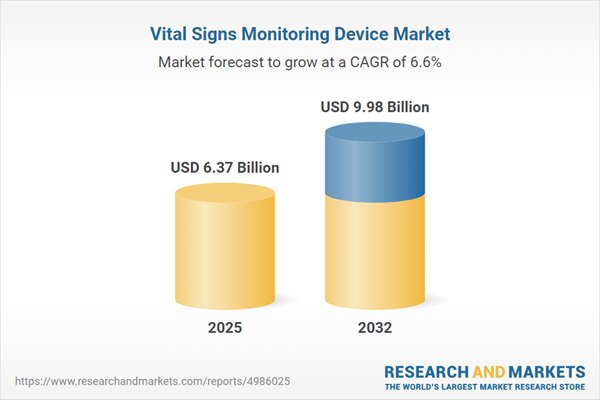Speak directly to the analyst to clarify any post sales queries you may have.
The vital signs monitoring device market is undergoing significant transformation, driven by the integration of advanced technologies into routine healthcare workflows. These innovations are reshaping both patient care and operational models, creating new opportunities for efficiency and quality improvements.
Market Snapshot of the Vital Signs Monitoring Device Market
The global vital signs monitoring device market grew from USD 5.97 billion in 2024 to USD 6.37 billion in 2025, and is projected to reach USD 9.98 billion by 2032 at a CAGR of 6.62%. This robust growth trajectory highlights increasing adoption in both clinical and home healthcare settings, reflecting heightened emphasis on continuous monitoring and connected care systems worldwide.
Scope & Segmentation: Navigating a Connected Market Landscape
- Product Types:
- Bedside monitors (multiparameter and single parameter)
- Central stations
- Handheld monitors (multiparameter and single parameter)
- Wearable monitors, including smart patches and smartwatches
- End Users:
- Ambulatory clinics
- Home healthcare providers
- Hospitals, inclusive of intensive care units
- Long-term care facilities
- Applications:
- Emergency monitoring (prehospital settings)
- Outpatient clinic monitoring
- Inpatient monitoring (ICU and ward monitoring)
- Home monitoring (remote patient surveillance)
- Sales Channels:
- Offline procurement
- Online retail platforms
- Regions Covered:
- Americas: United States, Canada, Mexico, Brazil, Argentina, Chile, Colombia, Peru
- Europe, Middle East, Africa: United Kingdom, Germany, France, Russia, Italy, Spain, Netherlands, Sweden, Poland, Switzerland, United Arab Emirates, Saudi Arabia, Qatar, Turkey, Israel, South Africa, Nigeria, Egypt, Kenya
- Asia-Pacific: China, India, Japan, Australia, South Korea, Indonesia, Thailand, Malaysia, Singapore, Taiwan
- Key Industry Players:
- GE HealthCare Technologies, Inc.
- Koninklijke Philips N.V.
- Nihon Kohden Corporation
- Mindray Medical International Limited
- Masimo Corporation
- Drägerwerk AG & Co. KGaA
- Hill-Rom Holdings, Inc.
- Spacelabs Healthcare, Inc.
- Contec Medical Systems Co., Ltd.
- EDAN Instruments, Inc.
Key Takeaways: Strategic Insights for Industry Stakeholders
- Emerging technologies such as artificial intelligence and Internet of Medical Things (IoMT) are enabling predictive analytics and seamless data transfer, supporting improved clinical decision-making and workflow efficiency.
- The miniaturization and wireless capabilities of wearable monitors, including smart patches and smartwatches, are extending the reach of continuous monitoring into home and ambulatory environments, improving patient mobility and engagement.
- Integration with cloud-based electronic health records is breaking down data silos, streamlining information access for clinicians, and fostering interoperability across healthcare networks.
- Adoption patterns vary across regions, influenced by local infrastructure, regulatory environments, and varying degrees of public and private investment in digital health solutions.
- Vendors are revising strategies in response to evolving supply chain dynamics, including the recent United States tariff adjustments on key device components, leading to changes in procurement and manufacturing approaches.
Tariff Impact on Supply Chain and Pricing
Recent United States tariff changes have introduced higher import duties on vital device components, prompting manufacturers and distributors to reassess supply chain configurations and adapt their sourcing or assembly locations. These adjustments are affecting pricing strategies, service contracts, and prompting increased focus on domestic production and long-term procurement planning.
Methodology & Data Sources
This market analysis combines structured interviews with stakeholders such as hospital decision-makers, procurement experts, and product managers, alongside a comprehensive review of regulatory records and patent filings. Secondary research of industry literature, including peer-reviewed journals and white papers, ensures data reliability and trend validation.
Why This Report Matters to Senior Decision-Makers
- Enables identification of high-growth application areas and technologies with tangible impact on operational goals.
- Informs effective resource allocation and risk mitigation by contextualizing regulatory and supply chain shifts.
- Supports precision in competitive benchmarking and market entry strategies with granular segmentation and regional insights.
Conclusion
The market for vital signs monitoring devices is advancing through a fusion of technology, operational re-engineering, and evolving policy landscapes. Stakeholders equipped with detailed insights and segmentation stand to make informed, future-proofed decisions across care delivery settings.
Additional Product Information:
- Purchase of this report includes 1 year online access with quarterly updates.
- This report can be updated on request. Please contact our Customer Experience team using the Ask a Question widget on our website.
Table of Contents
3. Executive Summary
4. Market Overview
7. Cumulative Impact of Artificial Intelligence 2025
Companies Mentioned
The companies profiled in this Vital Signs Monitoring Device market report include:- GE HealthCare Technologies, Inc.
- Koninklijke Philips N.V.
- Nihon Kohden Corporation
- Mindray Medical International Limited
- Masimo Corporation
- Drägerwerk AG & Co. KGaA
- Hill-Rom Holdings, Inc.
- Spacelabs Healthcare, Inc.
- Contec Medical Systems Co., Ltd.
- EDAN Instruments, Inc.
Table Information
| Report Attribute | Details |
|---|---|
| No. of Pages | 187 |
| Published | October 2025 |
| Forecast Period | 2025 - 2032 |
| Estimated Market Value ( USD | $ 6.37 Billion |
| Forecasted Market Value ( USD | $ 9.98 Billion |
| Compound Annual Growth Rate | 6.6% |
| Regions Covered | Global |
| No. of Companies Mentioned | 11 |









